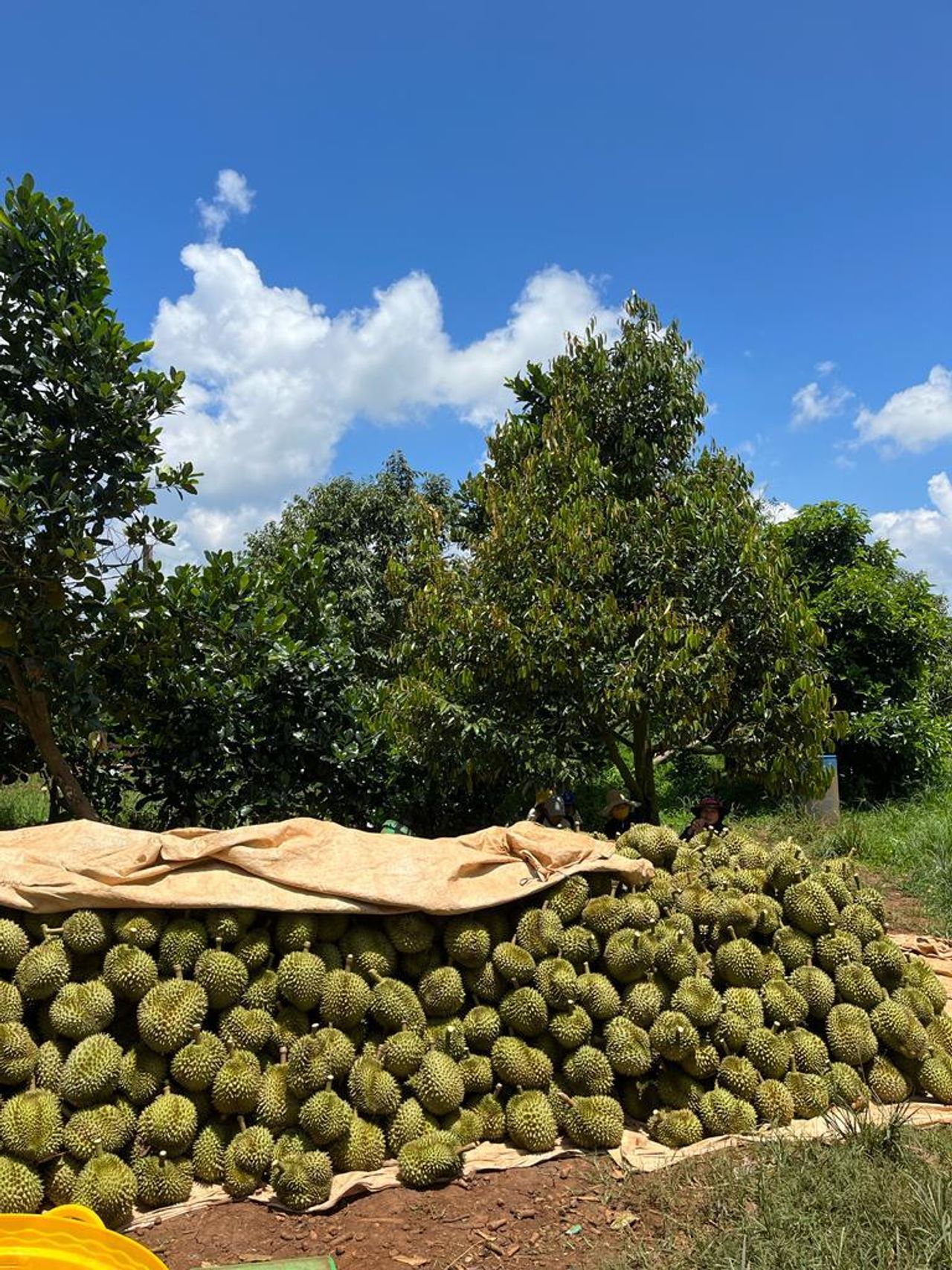As Chinese Tastes Change, Farmers Everywhere Rip Up and Replant
The windfall is transforming entire regions, but some are starting to worry: What if China stops buying?
EA YONG, Vietnam—In the verdant highlands of central Vietnam, warehouses the size of airplane hangars dominate small farming towns, bristling with mounds of tropical fruit. The bounty is destined for a colossal market: China.
Farmers are felling coffee trees traditionally grown in this cool hilly region to plant spiky durians, pungent fruits that have become wildly popular in China. They are reaping the windfall to buy new irrigation systems, pay off loans and build shiny marble facades to their homes.
“We locals aren’t just doing well, we can even be considered rich,” said Pham Van Trung, 54, as he ate a late lunch of pork and rice wine. Trung made $81,000 this year selling durian, and said the region was swarming with Chinese buyers.
China’s appetite for foreign produce has grown in recent decades along with the wealth of its consumers. The amount of food the world’s second most populous nation imports has risen to over $200 billion a year—more than any other country—from about $15 billion two decades ago, according to the World Trade Organization. Avocado farmers in Kenya, shrimp cultivators in India, soy producers in Russia and banana growers in Cambodia are all cashing in.
While economic growth in China has slowed recently and its population is shrinking, demand for nutrient-rich foods such as beef and tropical fruit has remained high.
Last year, the Chinese noshed through more than 800,000 metric tons of imported durian and nearly six million metric tons of imported meat—both world-leading totals. It bought 90 million metric tons of soybeans from overseas last year, accounting for roughly 60% of global trade, for use in making tofu and to feed the country’s hundreds of millions of pigs.
Feeding China’s massive middle class presents a historic opportunity for countries seeking to boost the incomes of people in poor, rural areas. But it also poses a quandary: how to tap in to its huge market without becoming dependent on a trade partner that can be fickle.
In recent years, China has restricted imports of Norwegian salmon, Taiwanese pineapples, Philippines bananas and Australian lobsters. It usually cites contamination, pests or issues with quality—but Beijing’s curbs have also often coincided with political disputes.
China slapped hefty antidumping duties on Australian wine exports in 2020 after Australia called for an independent probe into the origins of Covid-19. In 2012, China halted purchases from banana growers in the Philippines, saying mealybugs had been discovered in shipments, after a flare-up between the countries in the South China Sea.
“With the size of the Chinese economy, it can always use trade to punish an exporter,” said Yun Sun, director of the China program at the Stimson Center, a think tank in Washington, D.C. Selling to China is “an opportunity, and it is a risk,” she said.
The risk is higher because when the chance to export to China’s massive market opens up, often entire agricultural belts go all in. This can lead to what Sun calls “singularification,” or the concentration of a local economy around one product, making it vulnerable to disruption.

That is what appears to be happening in Vietnam’s central highlands. The region is famed for its Robusta coffee, which is sold around the world. But last year, Beijing opened the gates to large-scale imports of Vietnamese durian—and farmers here began uprooting their coffee crops. Traders flocked to snap up the produce, causing local prices to more than double this year.
Be Duc Huynh, a 26-year-old farmer who got rid of his entire coffee crop, said he makes about five times as much from a hectare of durian as he earned from coffee. He harvested four tons of durian this year, up from one ton last year—all of it destined for China.
China buys around 90% of durian exports from Vietnam, which also sells much of its dragon fruit, bananas, mangoes and jackfruit to its giant neighbour. In recent months around 60% of Vietnam’s fruit and vegetable exports have gone to China, up from one-third a decade ago, according to official figures compiled by data provider CEIC.
During the autumn harvest time, the village air carried the sharp smell of the fruit. Families stacked mounds of durian in front of their homes to entice traders, who thwacked the durian shells with knife handles to test for quality. Hard means it is too young; soft means it is ripe and can sell for a higher price.
On a recent afternoon, durian trader Nguyen Thai Huyen dug into the flesh with her painted-pink fingernails, tasting bits of durian to determine their ripeness. Huyen posts snappy videos on TikTok of her visits to plantations and the mountains of durian she has on offer.
“A few years ago people considered durian a crop to reduce poverty,” she said. “Now it is the million-dollar crop.”
She has tried selling to Japan, but said buyers there only take small amounts. She isn’t especially worried about being too reliant on China, though. She says durian’s popularity has room to grow in the country, where many are still unfamiliar with the fruit.
Vietnam’s government is less certain. Earlier this year the agriculture ministry issued a warning about what state media called reckless durian cultivation, saying many farmers were abandoning traditional crops such as coffee and rice and planting durian in areas unsuited to it. Agriculture experts cited in state media have encouraged farmers to develop alternative markets to China and try to sell more of their produce locally.
Traders say that is easier said than done. The fruit has few takers outside of the region, and recent high prices put durian out of reach of many local Vietnamese.
Still, farmers say they want to be careful. In September, some fruit exports including durian were halted after Beijing complained about mealybugs and other pests. It reminded farmers of a major disruption in January 2022 when truckloads of Vietnamese produce rotted after China sealed off its southern border to contain the spread of Covid-19.
H’Meng, a farmer who goes by one name, has planted hundreds of durian trees in recent years. Now, she said, she is planning to grow more coffee. The prices are more stable, she said, because the market for coffee isn’t focused on one nation.
“I’m worried about becoming too dependent on China,” she said.
 Copyright 2020, Dow Jones & Company, Inc. All Rights Reserved Worldwide. LEARN MORE
Copyright 2020, Dow Jones & Company, Inc. All Rights Reserved Worldwide. LEARN MORE
This stylish family home combines a classic palette and finishes with a flexible floorplan
Just 55 minutes from Sydney, make this your creative getaway located in the majestic Hawkesbury region.
Starting a new company with somebody requires a hard conversation. Better now than later.
You and a friend have a can’t-miss idea for a new business. You’ve got a great name, and the logo is perfect.
It is time to ask each other some hard questions.
Talking up front about tough subjects like how you work, how you deal with stress and your expectations for the business can save lots of headaches later. “Most issues are neutral when you discuss them ahead of time,” says Jane Brodsky , who ran a barre-and-spin studio with a partner for 10 years in Washington, D.C. “But in the heat of the moment, issues become personal and larger than they need to be.”
Here are crucial questions that should be settled at the start to help make the partnership succeed.
How did your family communicate?
Maybe you were raised in a family that talked through disagreements to find solutions. But maybe your partner grew up in a house where the loudest voice won. That could be a problem when issues arise in the business: Experts say that when people are under stress, they often fall back on behaviours that were imprinted at home—and different styles could clash.
At Happy Being, a company that sells nutritionally enhanced teas and drink powders, the three co-founders discussed communication style before they started the business. “We discovered that one partner gets triggered if he feels no one is listening,” says co-founder Dutch Buckley . “It goes back to an early fear of not being heard.” (For his part, co-founder Josemaria Silvestrini says that early on he “definitely needed the validation of being recognised and being right.”)
So, the three work at making sure everyone has a say in meetings, and they made a rule that no one’s work is ever belittled. On the flip side, when someone on the team accomplishes something, someone else on the team draws attention to it.
What does success look like to you? And failure?
While these may seem obvious—like, the business either succeeds or fails—everyone’s definition is different, and they are surprisingly specific. Certainly, monetary goals or anything that can be enumerated will help partners envision each other’s goals. Is one looking to grow slowly with customers and suppliers in the community and get to better than break even after three years, while the other wants to be cash-flow positive in year one and scale quickly to sell the business to a larger entity after 10 years? There’s a lot of success and failure in between those two outcomes, depending on your perspective.
Silvestrini of Happy Being recommends hashing it out together on the whiteboard until everyone agrees on an explicit definition of success for the company. “Hopefully, it’s an easy 10-minute conversation,” he says. “Because if founders have different objectives, the boat is going nowhere.”
What does everyone bring to the table?
It is crucial to discuss what each partner is contributing to the partnership in terms of expertise, experience, network and money. Kathryn Zambetti , an executive coach specialising in founder relationships, recommends taking an honest strengths-and-weaknesses inventory of yourself and your partner and then discussing what you both bring to the table. The exercise will help delineate which responsibilities naturally suit each partner, and it will highlight areas that will require additional work or outsourcing.
The clearer the roles can be defined, the better. If you are opening a bakery, you and your partner shouldn’t both be good at just making bread. Someone needs to handle marketing, suppliers, leases and licensing, financials and hiring and managing employees.
Why are you doing this?
You and your partner need to be in complete alignment on your motivations. Does this venture need to support your family or merely add to your vacation fund? Are you doing it to prove your father or your high-school econ teacher wrong? Any answer other than unfailing commitment to the mission or the product is a red flag.
“Your north star has to be something bigger than money to succeed,” says Buckley. “People will go through things that test them, but if money is the only motive, that won’t be enough.”
What pushes your buttons?
Just like in a marriage, you want to know best how to support and protect your business partner. Understanding what puts each of you in a fight-or-flight mode can be key to getting the best out of each other.
Do you need to be consulted on all decisions, or just major ones? Do you need to be recognized as the leader and sit at the head of the table? Do you fear having to downsize your home if the business fails?
What does your workday look like?
Does a day at the office mean working 9 to 5? Can the work be done remotely and on your own time? If you work well at night and need rapid responses to questions, is it a problem having a partner whose phone goes on “do not disturb” every evening at 7? Having the conversation and understanding expectations is key.
When Buckley started Happy Being, the team learned that one of the partners got up very early. “I had to tell him, ‘We don’t want 6 a.m. calls.’ ”
Do you like taking gambles?
A penchant for lottery tickets, Las Vegas gambling or high-adrenaline activities like skydiving shows a potential partner’s tolerance for risk and whether that aligns with your own. There will be countless decisions early on in a business concerning risk, and the partners need to be on the same page.
So ask about it. You go into the venture planning and hoping for success, but how much money or time is your partner willing to lose if it doesn’t succeed? How much of their parents’ or in-laws’ money would they bet on the partnership?
Is the business more important than the friendship?
Many business partners start as friends. But would you each be willing to give priority to making the right decision for the business, even if it means possibly hurting the friendship? Would you each be capable of letting the other one go if it was better for the company? Most advisers recommend choosing a partner who has a common business goal and letting the friendship build from that, rather than trying to build a partnership on top of a strong friendship.
“Your business partner will be one of your most intense relationships, but it shouldn’t fulfill every role in your life,” says Amy Jurkowitz, entrepreneur and co-founder of branding adviser Bread Ventures. “You need to be compatible in how much energy you will both put into the business.”
If the partnership doesn’t work out, how will it end?
A co-founder relationship is a binding agreement with financial and emotional repercussions, just like a marriage. But starting a business has the added stress of having the company—the baby—arrive on day one. If there is a divorce, who gets custody?
The more specific you can be about potential breakups, the better. If you are both putting capital in at the start, would you expect to get that out if you exited? What if, several years in, one partner can’t continue to struggle without a regular paycheck and leaves—and the next year the company finally turns a profit or is bought by another company? Would the partner who left get a share of the money?
These discussions should help make it clear that the survival of the company—and not the partnership or the friendship—is the ultimate goal. Those who have been through a business breakup recommend involving a third party to help sort through these issues at the outset.
This stylish family home combines a classic palette and finishes with a flexible floorplan
Consumers are going to gravitate toward applications powered by the buzzy new technology, analyst Michael Wolf predicts























